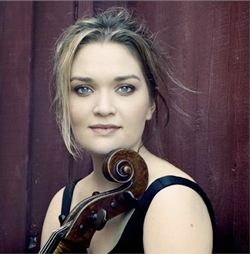|
Symphony
FROM THE NEW WORLD TO THE OLD WORLD
by Peter Lert
Saturday, June 14, 2025
Chamber
MC2 DUO RECITAL CLOSES 222'S SEASON
by Terry McNeill
Saturday, June 14, 2025
Choral and Vocal
CANTIAMO SONOMA'S LUSCIOUS A CAPELLA SINGING IN SEASON ENDING CONCERT
by Pamela Hicks Gailey
Sunday, June 8, 2025
Symphony
SRS SEASON ENDS WITH RESOUNDING TA-TA-TA-BANG
by Terry McNeill
Sunday, June 1, 2025
Symphony
YOUTHFUL VIRTUOSITY ON DISPLAY AT USO'S MAY CONCERTS
by Peter Lert
Saturday, May 17, 2025
Symphony
MYSTICAL PLANETS AND LIVELY GERSHWIN ORTIZ AT FINAL SRS CONCERT
by Peter Lert
Sunday, May 4, 2025
Symphony
VSO'S CONCERT MUSIC OF TIME, MUSIC OF PLACE
by Peter Lert
Sunday, April 27, 2025
VOCAL ELEGANCE AND FIRE AT THE 222'S RECITAL APRIL 26
by Pamela Hicks Gailey
Saturday, April 26, 2025
CANTIAMO SONOMA SINGS AN INSPIRED GOOD FRIDAY MOZART REQUIEM CONCERT
by Pamela Hicks Gailey
Friday, April 18, 2025
DRAMATIC SHOSTAKOVICH SYMPHONY CLOSES PHILHARMONIC'S 25TH SEASON
by Terry McNeill
Sunday, April 13, 2025
|
 |
 Cellist Sæunn Thorsteinsdóttir |
KNOTTY CELLO MUSIC THAT WAS (MOSTLY) EASY TO LOVE
by Terry McNeill
Sunday, February 1, 2015
Notable cello concerts have recently graced Sonoma County with Edward Arron’s Oakmont recital and Yo Yo Ma’s sterling solo outing in Weill. So it was not surprising that Sæunn Thorsteindóttir walked onto the Schroeder Hall stage Feb. 1 with pianist Elizabeth Roe and found a packed house of non-Superbowl fans.
In the first half contrasts abounded, beginning with the charming Beethoven Variations on “Bei Männern” from the Magic Flute and ending with the demanding Britten Sonata from 1961. The seven Beethoven variations served as an excellent warm up work, the balances good and the cellist using chaste vibrato and a secure and radiant bow style. Acoustics in the hall gave the instrument a pellucid sound, carrying easily to upper rows of seats.
The Britten is a tough work to love with sad, lyrical and restless sections combining in its five movements. Using the score as she did throughout the recital Ms. Thorsteindóttir played the long first movement with intensity, ending it with an extended tranquil fermata that was echoed by Ms. Roe’s gentile right hand tremolo. The aggressive pizzicato technique in the Scherzo was juxtaposed by demanding bursts from the piano, a question and answer dialogue that was compelling.
A plodding dirge characterized the following Elegia with bracing washes of sound and broad notes from the cello and hushed up-and-down octave jumps from the piano. The playing in the fourth movement caught the bouncy and banal nature of the music that turned at times to eerie and strident cello notes high on the fingerboard.
Skittish outbursts permeated the playing in the concluding finale and the tempos were fast but never out of control. The unison playing was faultless. The applause was substantial but not protracted.
Rachmaninoff’s early Sonata in G Minor, an easy piece to love, took up the entire second half and received a generous and grand reading. Ms. Thorsteindóttir doesn’t command a big outgoing sound, but she has a salutary tone quality and was ready to defer pride of place to her partner in many sections. The Rachmaninoff piece needs a pianist with a big technique and profile, and Ms. Roe was up to the task. As is well known with Rachmaninoff there are a lot of notes (difficult ones too) but if some are skipped or smudged the texture isn’t quite right. The pianist’s playing occasionally had this result and covered the cellist with extended use of the shift pedal and lavish employment of the damper pedal.
The second and third movement performances were highlights of the concert, especially in the provocative scherzo where the players were on fire with inspiration. The themes overflowed with passion. In the famous Largo Ms. Thorsteindóttir’s first entry following the lovely piano introduction was opulently colored and her conception throughout was subtle and restrained.
The playing of the weighty themes in the finale lacked clarity but was never wanting in momentum and potency. This music animated the audience of 250 and a standing ovation resulted.
Ms. Thorsteindóttir announced an encore, the short slow movement from the Chopin G Minor Sonata, Op. 65. Here the playing was captivating, each phrase integrated in a shapely and prismatic whole.
|
